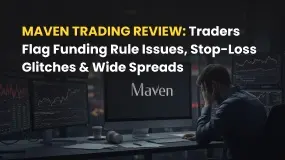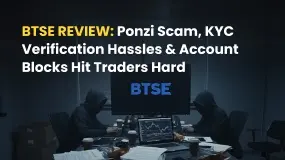简体中文
繁體中文
English
Pусский
日本語
ภาษาไทย
Tiếng Việt
Bahasa Indonesia
Español
हिन्दी
Filippiiniläinen
Français
Deutsch
Português
Türkçe
한국어
العربية
How to Automate Forex and Crypto Trading for Better Profits
Abstract:Find out how automating Forex and crypto trading is changing the game. Explore the tools, strategies, and steps traders use to save time and maximize profits.

Trading in the fast-moving worlds of Forex and cryptocurrency can be both exciting and overwhelming. The constant need to monitor markets, analyze trends, and make quick decisions can leave even the most dedicated traders feeling stretched thin. That's where automation steps in, offering a way to simplify the process, save time, and even improve your bottom line. Let's dive into what automated trading is, how it can benefit you, and how to get started with tools and strategies that work.
What Is Automated Trading in Forex and Crypto?
Automated trading, often called algo trading or bot trading, uses specialized software to make trades for you based on pre-set rules. These systems take over tasks like analyzing market data, identifying opportunities, and executing trades—all without requiring you to hover over your computer 24/7.
In Forex, bots monitor currency pair movements, while in crypto, they track trends and prices across digital assets. These tools use algorithms built on technical analysis, historical data, and market indicators, making decisions faster and sometimes more accurately than a human could.
Why Automate Your Trades?
Automated trading offers a ton of perks, especially if you're trying to balance trading with other commitments or just want to trade smarter. Here are some of the biggest benefits:
- Save Time: Bots work around the clock, seizing opportunities while you sleep or focus on other things.
- No More Emotional Decisions: Say goodbye to trading out of fear or greed. Bots stick to the plan, helping you avoid impulsive mistakes.
- Test Strategies Safely: You can use historical data to see how a bot would perform before risking real money.
- Fast and Accurate: Bots analyze huge amounts of data and make decisions in milliseconds—faster than any human.
- Scale Up Easily: Automation lets you juggle multiple accounts or strategies, something that's nearly impossible to do manually.

The Best Tools and Platforms for Automated Trading
Getting started with automated trading begins with finding the right platform or tool. Here are some popular options:
- MetaTrader 4 and 5 (MT4/MT5): Perfect for Forex traders, offering customizable bots called Expert Advisors (EAs).
- TradingView: Known for its powerful charting tools, it integrates with bots for the smooth execution of trades.
- 3Commas: A favorite among crypto traders, offering tools for strategies from basic to advanced.
- Cryptohopper: Great for beginners, it features pre-set templates and a bot marketplace.
- Binance API: For advanced users, this API lets you design custom bots for one of the largest crypto exchanges.
How to Set Up an Automated Trading System
Here's a simple roadmap to get your automated trading system up and running:
- Define Your Goals: Are you chasing quick profits, long-term growth, or diversification? Clarify this upfront.
- Pick a Platform: Choose one that matches your skill level and trading style. Check factors like fees and user-friendliness.
- Select or Create a Bot: If you're tech-savvy, build your own bot. Otherwise, opt for pre-made solutions from platforms like Cryptohopper.
- Backtest Your Bot: Use past market data to see how the bot performs. Fine-tune until it meets your expectations.
- Set Risk Limits: Define stop-loss levels and position sizes to protect your capital.
- Monitor and Adjust: Automation isn't completely hands-off. Keep an eye on your bot's performance and tweak it as needed.
Strategies for Getting the Most Out of Trading Bots
Even with automation, having a solid game plan is key. Here are some tried-and-true strategies to maximize your profits:
- Trend Following: Program your bot to ride market trends—buying when prices rise and selling when they fall.
- Arbitrage: Use bots to spot price differences between exchanges and profit by buying low and selling high.
- Grid Trading: Set up your bot to place orders at regular price intervals, capturing profits from market fluctuations.
- Dollar-Cost Averaging (DCA): Automate regular investments in an asset to reduce the impact of market volatility.
- High-Frequency Trading (HFT): For advanced users, this strategy involves executing a large number of trades in a short period to capitalize on small price movements.
Final Thoughts
Automating your trades can free up your time, reduce stress, and potentially improve your results. But it's not a magic bullet. The key to success lies in choosing the right tools, testing your strategies thoroughly, and staying actively involved to make adjustments as needed.
With the right balance of automation and sound trading principles, you can give yourself an edge in the ever-changing Forex and crypto markets. Whether you're just starting out or looking to level up your skills, embracing automation could be the breakthrough you've been waiting for.

Disclaimer:
The views in this article only represent the author's personal views, and do not constitute investment advice on this platform. This platform does not guarantee the accuracy, completeness and timeliness of the information in the article, and will not be liable for any loss caused by the use of or reliance on the information in the article.
Read more

Maven Trading Review: Traders Flag Funding Rule Issues, Stop-Loss Glitches & Wide Spreads
Are you facing funding issues with Maven Trading, a UK-based prop trading firm? Do you find Mavin trading rules concerning stop-loss and other aspects strange and loss-making? Does the funding program access come with higher spreads? Does the trading data offered on the Maven Trading login differ from what’s available on the popular TradingView platform? These are some specific issues concerning traders at Maven Trading. Upset by these untoward financial incidents, some traders shared complaints while sharing the Maven Trading Review. We have shared some of their complaints in this article. Take a look.

BTSE Review: Ponzi Scam, KYC Verification Hassles & Account Blocks Hit Traders Hard
Have you lost your capital with BTSE’s Ponzi scam? Did the forex broker onboard you by promising no KYC verification on both deposits and withdrawals, only to be proven wrong in real time? Have you been facing account blocks by the Virgin Islands-based forex broker? These complaints have become usual with traders at BTSE Exchange. In this BTSE review article, we have shared some of these complaints for you to look at. Read on!

Inzo Broker Review 2025: Is It Legit or a High-Risk Gamble?
When you ask, "Is inzo broker legit?" you want a clear, straight answer before putting your money at risk. The truth about Inzo Broker is complicated. Finding out if it's legitimate means looking carefully at its rules, trading setup, and most importantly, the real experiences of traders who have used it. The broker shows a mixed picture - it has official paperwork from an offshore regulator, but it also has many user warnings about how it operates. This review gives you a fair and fact-based investigation. We will break down all the information we can find, from company records to serious user complaints, so you can make your own clear decision.

INZO Broker No Deposit Bonus: A 2025 Deep Dive into Its Offers and Risks
Traders looking for an "inzo broker no deposit bonus" should understand an important difference. While this term is popular, our research shows that the broker's current promotions focus on a $30 welcome bonus and a 30% deposit bonus, rather than a true no-deposit offer. A no-deposit bonus usually gives trading funds without requiring any capital from the client first. In contrast, welcome and deposit bonuses often have rules tied to funding an account or meeting specific trading amounts before profits can be taken out. This article gives a complete, balanced look at INZO's bonus structure, how it operates, and the major risks shown by real trader experiences. Read on!
WikiFX Broker
Latest News
Forex Expert Recruitment Event – Sharing Insights, Building Rewards
Admirals Cancels UAE License as Part of Global Restructuring
Moomoo Singapore Opens Investor Boutiques to Strengthen Community
OmegaPro Review: Traders Flood Comment Sections with Withdrawal Denials & Scam Complaints
An Unbiased Review of INZO Broker for Indian Traders: What You Must Know
Is Fyntura a Regulated Broker? A Complete 2025 Broker Review
PINAKINE Broker India Review 2025: A Complete Guide to Safety and Services
Is Inzo Broker Safe or a Scam? An Evidence-Based Analysis for Traders
Is Uniglobe Markets Legit? A 2025 Simple Guide to Its Safety, Services, and User Warnings
Is Forex Zone Trading Regulated and Licensed?
Currency Calculator



